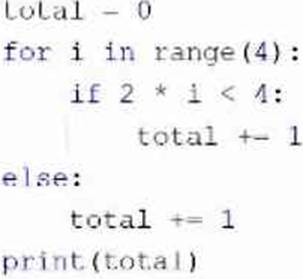What happens when the user runs the following code?
What happens when the user runs the following code?

A . The code outputs 3.
B . The code outputs 2.
C . The code enters an infinite loop.
D . The code outputs 1.
Answer: B
Explanation:
The code snippet that you have sent is calculating the value of a variable “total” based on the values in the range of 0 to 3.
The code is as follows:
total = 0 for i in range(0, 3): if i % 2 == 0: total = total + 1 else: total = total + 2 print(total)
The code starts with assigning the value 0 to the variable “total”. Then, it enters a for loop that iterates over the values 0, 1, and 2 (the range function excludes the upper bound). Inside the loop, the code checks if the current value of “i” is even or odd using the modulo operator (%). If “i” is even, the code adds 1 to the value of “total”. If “i” is odd, the code adds 2 to the value of “total”. The loop ends when “i” reaches 3, and the code prints the final value of “total” to the screen.
The code outputs 2 to the screen, because the value of “total” changes as follows:
When i = 0, total = 0 + 1 = 1
When i = 1, total = 1 + 2 = 3
When i = 2, total = 3 + 1 = 4
When i = 3, the loop ends and total = 4 is printed
Therefore, the correct answer is B. The code outputs 2.
Reference: [Python Institute – Entry-Level Python Programmer Certification]
Latest PCEP-30-02 Dumps Valid Version with 124 Q&As
Latest And Valid Q&A | Instant Download | Once Fail, Full Refund

